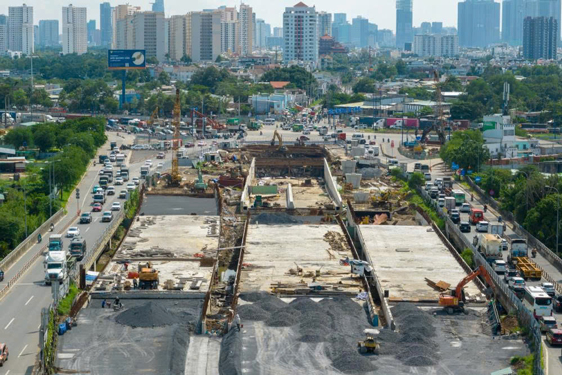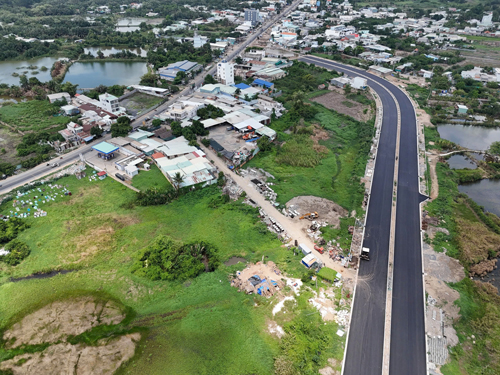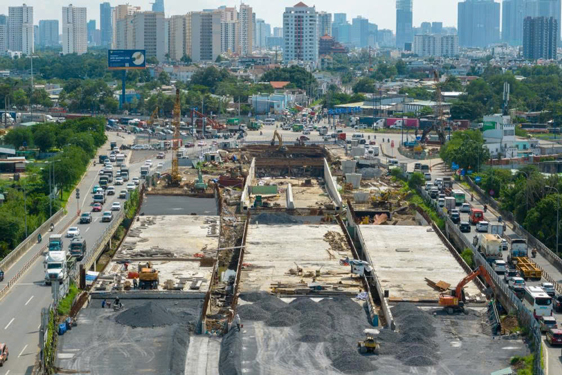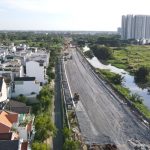At the intersection of Nguyen Van Linh and Nguyen Huu Tho streets (District 7) on August 14, Nguoi Lao Dong reporters witnessed an incessant flow of vehicles from the Mekong Delta provinces entering Ho Chi Minh City via Nguyen Van Linh Street, most of which were container trucks and cargo trucks carrying goods and agricultural products. A similar scene of congested traffic could be observed in the opposite direction.
An Unpleasant Experience
Owing to the heavy burden of cargo trucks, some sections of Nguyen Van Linh Street near the construction site of the Nguyen Van Linh – Nguyen Huu Tho intersection project have deteriorated, with the road surface peeling and potholes appearing. Phuong, a young truck driver, shared that he has only been on the job for a few weeks but has already experienced the discomfort of congestion and bumpy rides several times.

HC1 underpass, part of the An Phu intersection project, is set to open by the end of 2024.
“Sometimes I have to focus twice as hard on driving, and there’s also the pressure of timely deliveries. It’s really exhausting…” he trailed off, hitting the brakes and instinctively honking before a road depression.
At the eastern gateway, the An Phu intersection (Thu Duc City) leading to the Ho Chi Minh City – Long Thanh – Dau Giay Expressway doesn’t fare much better, with Mai Chi Tho, Do Xuan Hop, and Vo Chi Cong streets frequently congested.
Mr. Nguyen Van Hieu (District 12), a regular commuter on the Ho Chi Minh City – Long Thanh – Dau Giay Expressway, recounted his exasperation when traveling with his family to vacation spots like Vung Tau and Phan Thiet. Despite opting for the expressway to save time, he has endured delays of up to 30-45 minutes just to get past the Mai Chi Tho section. Once on the expressway, more congestion awaits, sometimes taking up to 3 hours to reach National Highway 51.
“Everyone is eagerly awaiting the completion of the An Phu intersection to ease the burden on the eastern gateway. This would facilitate tourism and trade between Ho Chi Minh City and the Southeast region,” Mr. Hieu expressed.
Meanwhile, many shake their heads in dismay when mentioning the “three haunting roads” of Truong Chinh, Cong Hoa, and Cach Mang Thang Tam near Tan Son Nhat Airport in Tan Binh District. As these roads connect outlying districts with the city center, they are perpetually congested during peak hours.
A Brighter Picture Ahead
As the economic hub of Vietnam and home to several major cargo ports, Ho Chi Minh City boasts a vibrant transport sector. However, this also means that the gateway roads connecting the city with the Southeast region, the Mekong Delta, and Tan Son Nhat Airport are often overloaded. Fortunately, this situation is set to change by the end of 2024 with the completion of several key projects.
Assessing the city’s transport landscape in 2024, Mr. Luong Minh Phuc, Director of the Ho Chi Minh City Transport Project Management Board, affirmed that alongside efforts to ensure the progress of Ring Road 3 and the Ho Chi Minh City – Moc Bai Expressway, other ongoing projects are on track to meet their deadlines.
Among them is a group of projects aimed at reducing congestion at the Tan Son Nhat Airport gateways, including the construction of the Tran Quoc Hoan – Cong Hoa road, the expansion of Hoang Hoa Tham Street, and the construction of the Tan Ky Tan Quy Bridge. These projects are slated for completion in December 2024 and will help alleviate traffic on the airport gateway roads of Truong Chinh, Cong Hoa, and Cach Mang Thang Tam.
For the southern gateway, the Nguyen Van Linh – Nguyen Huu Tho underpass project is on course for completion and opening to traffic on December 31, 2024. Simultaneously, a 4.3-km section of the National Highway 50 expansion project will be opened to traffic, along with the Rach Dia Bridge connecting District 7 and Nha Be District.

The current state of the 4.3-km National Highway 50 expansion project.
In the eastern gateway, projects such as the Nam Ly Bridge and one unit of the Tang Long Bridge construction project are nearing completion. Notably, the HC1 underpass of the An Phu intersection project is also on track to be finished in December 2024.
According to Mr. Luong Minh Phuc, there is no need to wait for the entire project to be completed before putting finished components to use. For instance, on August 10, the Transport Project Management Board opened the Phan Thuc Duyen underpass, which runs from Hoang Van Thu Street to Thang Long Street as part of the Tran Quoc Hoan – Cong Hoa road project. This underpass helps reduce traffic volume from Tan Son Nhat Airport to the Lang Cha Ca roundabout.
“The completion of these projects and components will make commuting through the gateways more convenient for residents. This, in turn, will enhance trade connectivity and promote socio-economic development between Ho Chi Minh City and the Mekong Delta and Southeast regions,” Mr. Phuc remarked.
Prompt Decision-Making for Thu Thiem 4 Bridge
Regarding the city center, the Ho Chi Minh City People’s Committee has recently sent an urgent dispatch to the Ministry of Transport regarding the implementation of the Thu Thiem 4 Bridge construction project to meet transportation needs and promote socio-economic development.
Based on the current status, planning orientation, and traffic demand, the proposed Thu Thiem 4 Bridge has a total length of over 2.1 km (with the main bridge spanning more than 1.6 km), accommodating six lanes, and featuring a navigational height of 80mx15m. Once completed, the bridge will effectively serve the Port of Nha Rong and Khanh Hoi, enhance the aesthetics of the Saigon River area, and boost the city’s architectural landscape.
The Ho Chi Minh City People’s Committee has requested the Ministry of Transport to consider and provide feedback to finalize the pre-feasibility study report for the project. This will pave the way for submitting the project to the competent authorities for approval and investment decision-making.
Ph.Anh
Comprehensive regional connectivity
In addition to building strong physical infrastructure, Ho Chi Minh City needs to strengthen its soft connections with other provinces in the region in order to promote economic development. This includes prioritizing the training of skilled workforce and ensuring access to quality healthcare.
Emotional Kieu people when admiring Ho Chi Minh City from Metro Line 1
Ho Chi Minh City has undergone a remarkable transformation since the day I left. It now boasts a completely different appearance, exuding a fresh and vibrant energy. This sentiment was captured by Mr. Nguyen Duong Nam Phuong, a Vietnamese American, who was amazed by the city’s newfound liveliness.




















